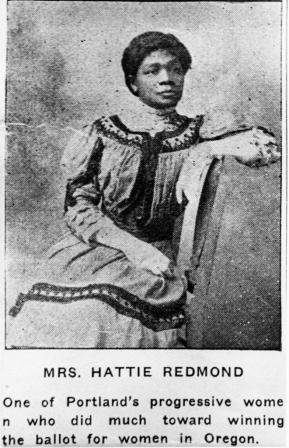 Photo #ba017787 of Hattie Redmond, courtesy of Oregon Historical Society Photo #ba017787 of Hattie Redmond, courtesy of Oregon Historical Society |
An obscure grave in Portland's Lone Fir Cemetery is the final resting place of a Black woman who helped change the world. Her name was Hattie Redmond, and she was a leader in the 1912 campaign that won equal voting rights for Oregon women.
Now, 100 years later, the Century of Action committee plans to give Redmond's grave some long overdue respect. Century of Action is leading the centennial celebrations for the women's voting rights victory. And they are looking for family, friends, or anyone with information about Hattie Redmond, to come forward and help design a headstone worthy of her achievements.
"We have a wonderful story to celebrate in telling Hattie's story and how she helped bring about these changes of such great significance," says former Sen. Avel Gordly. "It is so wonderful to have that history."
Century of Action project director, Janice Dilg, has been poring over old newspapers and city records to find out as much as possible about this unsung Portland hero.
"We've been piecing together some information," Dilg says. "She lived in Multnomah County her entire life. She was married to Emerson Redmond, and we're not sure when he died, but she was a widow. And she was very active in her church, one of the founding Black churches in Portland: Mt. Olivet Baptist Church."
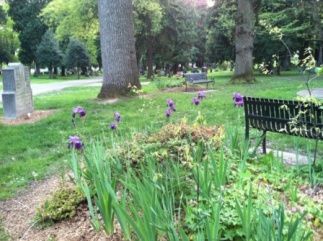 Redmond is buried in Lone Fir Cemetery, named one of the Top 10 Cemeteries to Visit by National Geographic magazine Redmond is buried in Lone Fir Cemetery, named one of the Top 10 Cemeteries to Visit by National Geographic magazine |
Black Women Worked For the Vote
Redmond was Secretary, and later President, of the Colored Women's Equal Suffrage League, which had grown out of the Colored Women's Council of Portland. Black women formed the Women's Council of Portland in early 1912, with the mission of helping, "poor and unfortunate women".
Soon after, women from five different churches joined forces to campaign for the vote. One early meeting was held at the African Methodist Church, 68 North 10th Street. Other meetings were held at Mt. Olivet, 85 N.W. Seventh St., and at the library. Among the early Black women leaders named in news articles were: Katherine Gray, Edith Gray, Mrs. Lancaster, Mrs. Lizzie K. Weeks, Mrs. Virgil Keene, Mrs. Will Allen and Mrs. Bonnie Bogle.
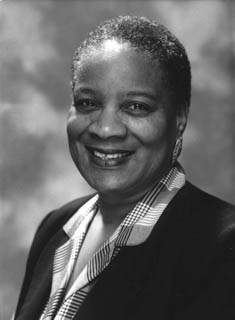 Former Sen. Avel Gordly Former Sen. Avel Gordly |
"The women involved in that were involved in all kinds of programs, organizations and activities that benefited the community," Dilg says. "The suffrage campaign really developed out of that."
Former Sen. Gordly, remembers the key role that the Black women's clubs played in providing social services and education in Portland's Black community. Her maternal grandmother Alberta Louise Randolph, for example, often held meetings at her home on North Williams Avenue. Club women were mentors, health advocates and cultural leaders, Gordly notes, promoting African American history and forming book clubs, as well as working for civil rights.
"These women poured so much of themselves into building community," Gordly says. "Growing up I was very aware of the activism of these women who always seemed to be doing good in the community. They raised money for scholarships. They read books together. Their motto as club women was, 'Lifting as We Climb.'
"These were women who were also working outside of the home. In my grandmother's case, she did domestic work in the homes of wealthy white families. And even after doing all of that, she did a mighty job of taking care of her own family and being very active in her church."
A Headstone to Honor Redmond's Achievements
Plans are underway to dedicate a headstone for Hattie Redmond, July 21, 2012, at a special ceremony in the Lone Fir Cemetery.
"The Friends of the Lone Fir Cemetery are putting together funds for the headstone," Dilg says. "And we want to make sure that any living descendants are fully on board with that plan.
"It appears that Hattie and Emerson did not have children, but we have not determined if there are any friends or family who would like to be involved. And we are historians so we're always looking for a better photograph or a more accurate story."
So far, only one photograph of Hattie Redmond has been located.
The most recent news story about Redmond, is from 1941. The Oregonian reported that Redmond had sued John F. Ebele for $15,000 after his car hit her on S.E. Powell Boulevard at 33rd Avenue.
 Lone Fir Cemetery: Instagram photo Lone Fir Cemetery: Instagram photo |
Redmond is described in the Bosco-Milligan Foundation's 1997 'Cornerstones of Community,' as a janitor at the Federal Building. Her 1913 voter registration card says she was a hairdresser. What's beyond doubt is that she was a leader in the movement for equal rights.
"The important thing is that obviously African American women were battling both racism and sexism," says Kimberly Jensen, the Western Oregon University professor who is vice president of the Oregon Women's History Consortium, which runs the Century of Action project.
"Their work is very significant. They organized among five churches and they had links to the National Association of Colored Women's Clubs. So they were very much aware of the suffragist movement here in Portland, but also they were linked to the national movement."
Then as now, activists had to work to build support for their cause.
"At the Aug. 1 meeting of the Central Campaign Committee, the group announced that it had doubled its membership and that 'the editor of their paper, The Advocate, favored the movement,'" writes Professor Jensen in her Oregon Historical Quarterly article about suffragist Esther Pohl Lovejoy and the 1912 campaign, "Neither Head nor Tail to the Campaign."
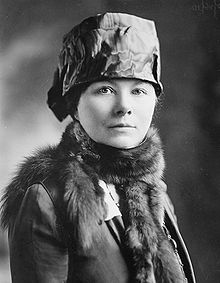 Esther Pohl Lovejoy Esther Pohl Lovejoy |
Getting supporters to meetings wasn't always easy.
"Mrs. Redmond says that while there were 2,500 women of voting age in the city, Just 14 women attended the meeting," The Oregonian reported, Sept. 17, 1912. "She attributed this largely to the influence of their husbands and ignorance of the benefits to be derived from the franchise."
Black Women Were Key to 1912 Victory
The law that gave the vote to Oregon women did pass in 1912. The margin was small, 52 percent in favor, compared to just 37 percent when the same issue was on the ballot in 1910. Jensen argues that the victory came about because the movement built a coalition that crossed race and class lines. Black Portlanders and also the Chinese American community, were a key part of that strategy.
In fact, Black women had been pushing hard for voting rights from the earliest days of the women's suffrage movement. So in 1872, along with women across the nation, Mary Beatty and Abigail Scott Duniway turned out to the polls and tried to vote. Beatty was described in news reports as a "colored" woman.
But racism became more of a problem toward the turn of the century and Black women were excluded from working with White suffragists. Duniway advocated a strategy called "the still hunt," which rejected confrontation in favor of winning over powerful male voters with humor and gentle persuasion. The new generation embraced in-your-face activism and coalition building.
"In Portland, women argued that they needed the vote to promote legislation to build clean communities and to ensure pure food and milk," Jensen says.
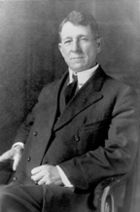 Portland Mayor and later Oregon Senator Harry Lane was a prominent male supporter of women's suffrage Portland Mayor and later Oregon Senator Harry Lane was a prominent male supporter of women's suffrage |
Food safety was an important issue. Esther Pohl Lovejoy, a doctor and from 1905-1909 Portland's City Health Officer, complained that, "for several years the women of this city were unable to secure any protection" when "hundreds of little children" died from "an impure milk supply."
Pohl Lovejoy's own son Freddy was just 7 years old when he died from drinking "tainted milk."
"Having the vote meant you could have your say on a whole range of issues," Dilg says. "It gave them a tool that women didn't then have, to make their voices known."
Along with Hattie Redmond, other prominent campaigners for equal voting rights, Esther Pohl Lovejoy, Martha Caldwell Dalton and Mayor Harry Lane are buried in Lone Fir Cemetery.
Did Blacks Face Other Barriers to Voting?
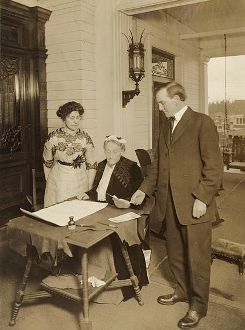 Abigail Scott Duniway signing first Equal Suffrage Proclamation ever made by a woman. Oregon Governor Oswald West, who had signed the Proclamation is shown looking on, and acting President Dr. Viola M. Coe is standing near. Courtesy of Wikipedia and the Library of Congress Abigail Scott Duniway signing first Equal Suffrage Proclamation ever made by a woman. Oregon Governor Oswald West, who had signed the Proclamation is shown looking on, and acting President Dr. Viola M. Coe is standing near. Courtesy of Wikipedia and the Library of Congress |
Finding out about the lives of people of color living in Portland 100 years ago is challenging. Several people who talked to The Skanner News about Redmond raised the issue of whether barriers still existed after the 1912 victory?
Jan Dilg and Kimberly Jensen say that to the best of their knowledge, Black women were entitled to vote after 1912.
Professor Darrell Millner at Portland State University says Black men were voting from 1870. That's the year the 15th Amendment was enacted, banning voting restrictions on race grounds. Millner says Black women were voting from 1912, eight years before the passage of the 19th amendment gave women across the nation the right to vote. Quintard Taylor, a history professor at the University of Washington, and the founder of blackpast.org, agrees.
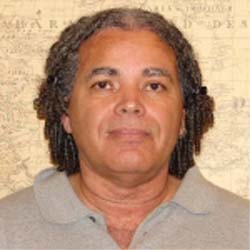 PSU Professor Darrel Milner is an expert in Oregon's African American history PSU Professor Darrel Milner is an expert in Oregon's African American history |
Proving that Redmond herself probably did vote, Terry D. Baxter a Multnomah County administrator, located and emailed The Skanner News a photograph of Hattie Redmond's voter registration card, filed in 1913.
Yet Oregon has a murky history of racial discrimination. From its earliest days, exclusion laws prevented Black Americans from settling or owning property in the state. And it was not until 1927 that the ban on Black residents was removed from the constitution.
Efforts to end discrimination in public places were rebuffed as late as 1950, when a move to outlaw discrimination in public places throughout the city of Portland was defeated. Beatrice Cannady, the journalist and co-editor of 'The Advocate,' lobbied Salem on the issue as early as 1919. But progress stalled. Decades later, after a campaign by the Portland NAACP with support from Sen. Mark Hatfield, Oregon's Public Accommodations Law was passed in April 1953.
Professor David Anthony, a former University of Oregon history professor now teaching at the University of California at Santa Cruz, directed us to a passage in Elizabeth McLagan's book, "A Peculiar Paradise: A History of Blacks in Oregon, 1788-1940." It notes that, "Article II. Section 6 of the OR Constitution states: "No Negro, Chinaman or Mulatto shall have right of suffrage (repealed 1927)."
When the 15th Amendment became national law in 1870, the Oregon Legislature refused to ratify it. However, Century of Action notes that the same year, a ruling from the Oregon Supreme Court affirmed the right of Black men to vote. As for the 19th Amendment, Oregon ratified it, soon after it passed in 1920, becoming the 25th state to do so. However, the state did not ratify the 15th Amendment until 1959.
If you have connection to Hattie Redmond or any information to offer, Century of Action wants to hear from you. Email [email protected]
If you have any photographs, writings or family stories about the first Black voters, The Skanner News would love to hear from you. [email protected]














































































































































































































































































































